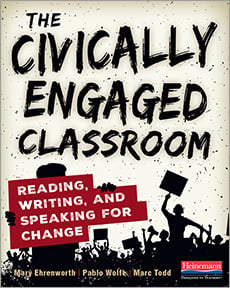
The following is from The Civically Engaged Classroom by Mary Ehrenworth, Pablo Wolfe, and Marc Todd.
Our work in supporting students as critical readers lies in giving them enough structure to support growth but not so much direction that they lose their sense of autonomy. Well-chosen prompts—when paired with the collaborative reading practices below—can provide that just-enough structure. Students can use analytical prompts such as these to question sources:
Reading Around the Text
- Read about the author. Ask: “Who are they—do they have an area of expertise? Does anything in their bio suggest any agendas?”
- Read for sources. Ask: “Where did the author get their information? Do the sources seem to represent any particular groups or coalitions?”
- Read other perspectives/sources. Ask: “Are there nuggets that appear in most sources or that suggest an underlying truth? Are there highly contested parts or versions?”
Reading for Warrant, or Reasoning
- Read for argument. Ask: “Does the author state an explicit opinion? Does the author try to lead their audience to an opinion? Do they acknowledge other opinions?”
- Read for evidence. Ask: “In what ways does the author support an opinion or claim? Is the evidence convincing, or does it seem slippery?”
- Read for angle. Ask: “What aspect of a big topic is the author spending most of their time on? What do they not mention, or spend little time on?”
Reading for Craft and Structure
- Read for the writer’s word choice. Ask: “Does the word choice suggest the sympathies of the author? Are there surprising word choices? Why might the author have made those choices?”
- Read for the writer’s techniques. Ask: “What writerly moves is the author using, and what effect do they have on you as a reader?”
- Read for structure. Ask: “How does the author lead me to ideas? How do the parts fit together?”
Reading for Representation and Perspective
- Read for audience. Ask: “Who is the author writing for? Who would benefit from this piece?”
- Read for voice and representation. Ask: “Who is included in this piece? Who is left out, marginalized, or distorted?”
- Read for #OwnVoices perspectives. Ask: “Whose stories are being told here, and whose voices are telling those stories?”
- Read for power and resistance. Ask: “How does this text reinforce existing powers (voices, groups, structures, narratives, points-of-view). How does it resist or disrupt those?”



